by Merle Hoffman
You’re going where? The insistent questioning by family and friends reverberated in my head as I flew over the blackness of the Bosphorus, the sky brilliant with stars..
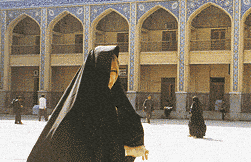
Photos: © Merle Hoffman
Traveling to Iran in the fall of last year, I journeyed much farther than anticipated. Media sound bytes and commentary defined my expectations: The fatwa against Salman Rushdie; American hostages; burned U.S. flags; oppression of women; political repression; religious fanaticism. My visual perceptions included the images of bearded young men with fists punching the air in passionate rage, and veiled women forming a moving sea of black shrouds. Massive crowds engaged in collective acts of transcendence that stretched my cross-cultural empathy and taxed my understanding.
What was this place really? This “rogue state” — this revolutionary, yet ancient society to which I was traveling?
I was entering Iran curiously, and somewhat apprehensively. Ultimately, I was to find that Iran entered me. It pushed my boundaries and transformed me in ways I never expected. The strangeness started on the plane. I learned that none of the Swiss Air crew ever disembarked. The plane landed just long enough to unload its passengers refuel and start back again.
The stewardess apologetically handed me the pre-landing forms. Was I carrying any liquor or unacceptable reading material into the Islamic Republic? I stared at my book on women pirates — a blood-red cover showing a swashbuckling heroine with a half-exposed breast. “Serious history,” I thought to myself with a grin. I would keep it. Two books on the psychology of serial killers could also pass muster as quintessential American culture, but the British Times Literary Supplement with a long piece on homosexuality would have to stay on the plane. (Last April, a 32-year-old Iranian lesbian was granted asylum in the U.S., after her home was raided twice by Revolutionary Guards, and her lover and a former girlfriend were both jailed because of their suspected sexual preferences.)
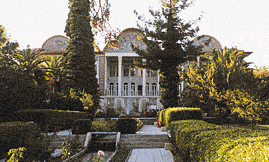
Shortly before landing I slipped into the restroom and prepared to go native. From the very beginning, Iran challenged my vanity. In order to conform to Islamic hijab, I was expected to cover my hair and neck, wear a long, loose dress, dark stockings or trousers, and forego cosmetics in public.
From my adolescent-bohemian days at New York’s High School of Music and Art, to the adult rituals of Manhattan fashion, black had always been my color, so the floor-length dark coat was not a problem. The head scarf was the issue. I’d purchased a large opaque one, and had practiced with it at home, throwing it over my shoulder in a dramatic gesture. But because I was always in motion, the damn thing kept falling off resulting in a dangerous display of blond hair. The scarf made my long hair, which is so much a part of my female self and self definition situationally unavailable to me. I felt neutered, de-sexualized.
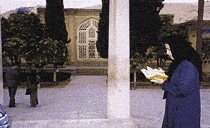
Below: At the tomb of Hafiz, Iranian visitors pause to read his romantic poetry.
But that was the point.
The associations I began making were brutal: Auschwitz, where the first thing done to the women — before the dogs and the gas — was to shave their heads in an attempt to dehumanize them; female collaborators during World War II being shamed by having their heads shaved.
Cross-dressing as a Muslim woman in a chador, I moved awkwardly into a socially constructed invisibility. But remarkably, by the time I left Iran I would find the restrictive coverings an unexpected revelation.
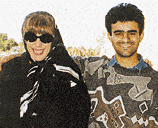
Interacting with other women in hijab was a distinctive experience. I felt totally concealed, yet strangely naked at the same time. Free from an individuality defined by attire, and with only one’s face exposed, the presented “self” can become more focused and authentic. All the usual and customary signifiers were unavailable. Without designer labels or rich textures to define, to specify one’s “caste,” for example, I could not process or calculate class and rank. For the first time, I inhabited a space without familiar roles or stereotypic assumptions. I could be in a nunnery, or an Orthodox shul — other worlds where an egalitarian uniformity of dress creates a more intense meritocracy of personality. It was a welcome relief.
The chador: woven prison, romantic shroud, encompassing, suffocating, oppressive. It was so difficult to hold correctly. Many women held theirs in their teeth, allowing them the use of both hands. I was always nervously clutching at the ends of mine to keep it acceptably in place.
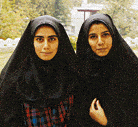
Iranian men on the other hand were free to dress as they chose. Most wore casual jackets and open shirts. When the mullahs declared ties to be a symbol of Western influence, Iran became the only country where wearing one is a political act.
So is dancing.
Since the revolution, the Islamic Republic allows no dancing. In one of the few restaurants now permitted to have live music, I forced myself to sit still while my body strained against the limitation. My shoulders, neck and head moved to the rhythm, while my feet tapped the floor. I turned and met the eyes of another woman. We danced together with our eyebrows, laughing knowingly through the boundaries.
Expressions of politics and religion were everywhere. At the airport and in the public spaces of Tehran, I was visually assaulted by enormous posters of the fiery, revolutionary leader Ayatollah Khomeini, and the current supreme religious leader, Ayatollah Ali Khamenei, who stared down at me with haughty patriarchal preeminence.
The sides of apartment buildings were covered with wall paintings of the martyrs of the Iran/Iraq war: state-created religious iconography — young men with saintly, serious eyes, and a touch of knowing in their faces — doubling as revolutionary graffiti. Later I would see their mothers on television detailing the brief life stories of their sons — poignant vignettes of suffering and loss, produced to reinforce the collective national experience of sacrifice and bonding. That was one channel. The other two aired either continual readings of the Koran, or serious discussions on art or nature. No Sally Jesse or Oprah here.
Then there was Qom, the center of Shiite Muslim teaching, the palpable heart of the religion and the revolution. I’d wanted to go there ever since I’d known I would visit Iran, drawn by what must be the intensity, the heaviness, the pure seriousness of the city. Khomeini studied here and the place has his mark.
In Qom, the mullahs were everywhere: long dark beards, pointed slippers, russet capes, books under their arms. The atmosphere was weighted with significance, expectation, and for women, danger of unintentional blasphemy. Not a hair must show; keep eyes cast down; don’t smile; don’t laugh; walk modestly. I was told that one can always tell a foreign woman, even in chador and from the back, because of the way we walk, stride really — purposeful movements the chador is intended to hinder.
I arrived at Qom’s main shrine just in time for midday prayer. Interestingly, in this ancient monastic city, the shrine where people worship is the burial site of a woman, Massumeh, a descendant of the Prophet.
I found myself surrounded by ranks of women, bowing, praying, placing their foreheads on small tablets of clay (one does not speak to God touching man-made substances). As I maneuvered my way through the undulating crowds, I was reminded of Orthodox Jewish synagogues. There, too, I have always been both fascinated and a little repelled by the solemn dark figures mouthing unintelligible prayers as they move their bodies ecstatically in ritual dialogue with the Divine. Here, in this most alien of places, where as a non-Muslim, yet alone a Jew, I had no right to be present, I felt an ambivalent familiarity.
Then a vision in black stood before me. I think it was a mother and child. I am sure about the child. I could gauge her age in her face and size. But the figure standing next to her was a mystery. Totally encased in black cloth, the face completely obscured by an embroidered covering, she stood absolutely still facing the shrine. I was transfixed by the pair’s solemnity, the strange beauty of this tableau, and wondered how the wrapped figure could possibly breathe.
My attention was drawn away from this exotic scene by another, a group of six men walking around the courtyard of the mosque, holding a corpse wrapped in a blanket above their heads. This ritual allows the family of the deceased to help the corpse pay his last respects. I later learned that the traditional souvenir visitors bring home from Qom is a shroud to be used at one’s death. I declined.
Even here in Qom, especially here, the politics can be explosive. The day before I visited there had been a demonstration by militant students against a leading cleric. He had issued a statement questioning the role of the Supreme Religious Leader, a constitutional position that is neither elected, nor responsible to the people. Tear gas was needed to dispel the demonstrators.
In Isfahan, the enchanting city of turquoise mosques, soaring minarets and tea houses on the river, the romance of the moment was broken when I noticed a mass of black chadors marching toward my taxi. Holding large political banners and chanting, they were the stereotype come to life. It was November 4th, the eighteenth anniversary of the occupation of the U.S. embassy and the taking of American hostages.
At my insistent questioning, my driver apologetically explained that the slogans were anti-American. But, he hastened to assure me, it is the government, not the people of the U.S., with whom some Iranians have a problem. But it felt more personal than political when sitting in the lobby of my hotel in Shiraz. I was struck by the large gold lettering above the entranceway reading “Down with USA.” This is a remnant of the early days of the revolution, and even though it is at odds with Iran’s newly emerging tourism, the slogan stays. Lest they forget?
Since the astonishing election of President Mohammad Khatami, the preferred candidate of the intelligentsia, social and political tensions have heightened. In his “message to the American people,” broadcast on CNN in January, Khatami praised the founders of America, suggested cultural and intellectual exchanges and acknowledged that the feelings of the American people had been “hurt” over the hostage crisis.
The Supreme Leader, Ayatollah Khamenei’s reaction was to support Khatami’s remarks and dismiss any ostensible disagreement as a “difference of taste.” However, he defended the seizure of the American hostages, calling it a “way to punish America,” and praised the student militants for the decency of not killing them.
Whatever the nuanced political maneuvrings between Iran and the U.S., I felt that President Khatami echoed the sentiments of my taxi driver with his praise of the “great American people,” and his desire to “crack the wall of mistrust” between Iran and America., And it was the people of Iran who defined the landscape of the place for me. The families and friends whose homes I visited every night. It was only there, on the inside, that the “personal,” as we define it in the West, was possible.
Inside, the scarfs, long coats and chadors of the day were put aside for designer suits or comfortable jeans. Fashionable accessories appeared, and hair in myriad styles escaped. Because the selling and consumption of liquor is prohibited, there was homemade vodka and wine. I ate rice flavored with rose petals, and danced energetically to tapes of traditional Iranian music.
Connections were fast and intense. Things that were forbidden on the outside, were allowed inside, looking, touching, embracing. Without the assaulting media saturation of consumerism, sex and violence that so often defines Western society, the smallest things became meaningful: the subtle eroticisms; the briefest hints of sensualities — as if the reality of the revolution outside enforced an interior hypersensitivity. I recalled my adolescence where so much of the excitement came from the danger of having lines to cross, boundaries to break. A time when anything was possible and fantasies of romance, adventure and enchanting places filled my mind.
It all came back to me in Shiraz, walking in one of the gardens for which Iran is famous. Particularly there where the delicate, disciplined parks create small green oases in an otherwise gray city. One expects to find Persian miniatures come to life — lovers in silk robes strolling through the pomegranate trees. Instead on a crisp fall day, with the graceful cyprus trees of Shiraz surrounding me, and the Zagros Mountains as a backdrop, I spotted three uniformed soldiers taking a stroll. In lieu of their customary guns, they each held prayer beads in their hands.
On that same day, I took a taxi to the tomb of Saadi, the Shakespeare of Persian literature, and when I asked the price of the ride, was told by the driver, “Pay me whatever you choose. It is a honor to take you to Saadi’s grave.” Unforgettable was the day I stood at the tomb of Hafiz, the revered thirteenth-century poet, while couples read his haunting words of love to each other, and kissed the Koran in gratitude for his life. Or the powerful silence in the thousand-year-old Jummah (Friday) Mosque in Isfahan just before midday prayer begins recalling and replicating centuries of the same moment.
And the day I was approached in Ali-Ghapu, a seventeenth century palace of Shah Abbas, by a young male student who, on hearing me speak English and learning I was an American, shouted joyfully “Michael Jackson, Pink Floyd, Danielle Steele.” Laughing, I replied, “not my taste,” and posed for pictures with him.
Learning that there were still 5,000 Jews left in Isfahan, I was determined to visit the ancient synagogue. I found it tucked away behind a street facade, its small door easily missed. A doe-eyed teenaged girl, who lived there with her mother, let me in. The synagogue was faded and worn, a sad remnant of what was once the center of a vibrant community. Chickens scratched in the courtyard; the once richly colored Persian rugs were now dimmed and stained; the only seating for a diminishing congregation, folding chairs. The poignancy of the decaying synagogue was augmented by the mother, who with tears in her eyes told me of the death last year from leukemia of her only son, at 27. With tears in my own eyes, I embraced her, and gave her what was for me a small donation, a gift for the synagogue. It was received as if I had given thousands of dollars. Perhaps I should have.
But it was the young girls of Iran who moved me most deeply. Resembling little novices, their black eyes stared out boldly from under their headcoverings. At a museum, which was previously one of the Shah’s palaces, I was surrounded by a group of them, ranging in age from 9 to 12. On a class outing, they were greatly interested in a foreigner, especially an American. “Is it better in the West?” “Should we leave and try to live there?” “Will I have a better life?” they asked me. I answered diplomatically that “one can build a good life anywhere.” But I wondered. Because I know that geography is destiny, and that there are many in her country who would deny them any opportunity to participate fully in society.
Just this past year, two Iranian leaders made that quite clear. On Tehran radio in July, Ayatollah Khamenei, said, “The idea that women should play a role in society just as men do is a negative, primitive, simple and childish notion.”
Or Justice Minister Ismail Shoushtari, who told the Jomhouri Islami newspaper, “When it comes to the defense of women’s rights, the notion of equality between men and women does not mean that women will no longer suffer discrimination. Moreover, the notion of equality between men and women does injustice to women.”
In a country where men are still automatically awarded custody of children, and women are routinely and institutionally discriminated against in terms of financial, judicial and social systems, just what is justice for Iranian women? Is it to be found in the details of Islamic law, under which, this past summer, the Iranian parliament approved a special bill to allow women being divorced to receive their prescribed alimony adjusted for inflation? The measure makes it mandatory for marriage license bureaus to register the price indicators in the marriage certificate at the time of the marriage.
Or is it found in the reality that despite the severe restrictions of the fundamentalist regime, women are more engaged in the life of their country than they were under the Shah? That they continue to slowly push barriers and move toward freedom. That their strength and energy are the hope and future of Iran, just as their mothers were the foundation and support of their families during the revolution. I only know that when I climbed aboard the Swiss Air plane to take me home, the first thing I did was to pull the scarf off my head, because I was free to do so. But removing symbols and metaphors is so much easier than dismantling the radical ideologies that placed them there.
Merle Hoffman is publisher/editor-in-chief of On The Issues magazine and founder/president of both Choices Women’s Medical Center, Inc., and Choices Mental Health Center.
